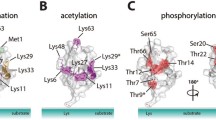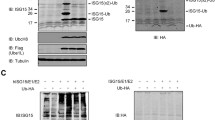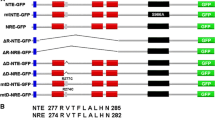Abstract
The ubiquitin–proteasome (Ub-Pr) degradation pathway regulates many cellular activities1,2, but how ubiquitinated substrates are targeted to the proteasome is not understood. We have shown previously that valosin-containing protein (VCP) physically and functionally targets the ubiquitinated nuclear factor κB inhibitor, IκBα to the proteasome for degradation3. VCP4 is an abundant and a highly conserved member of the AAA (ATPases associated with a variety of cellular activities) family5,6,7. Besides acting as a chaperone in membrane fusions, VCP has been shown to have a role in a number of seemingly unrelated cellular activities. Here we report that loss of VCP function results in an inhibition of Ub-Pr-mediated degradation and an accumulation of ubiquitinated proteins. VCP associates with ubiquitinated proteins through the direct binding of its amino-terminal domain to the multi-ubiquitin chains of substrates. Furthermore, its N-terminal domain is required in Ub-Pr-mediated degradation. We conclude that VCP is a multi-ubiquitin chain-targeting factor that is required in the degradation of many Ub-Pr pathway substrates, and provide a common mechanism that underlies many of the functions of VCP.



Similar content being viewed by others
References
Hochstrasser, M. Annu. Rev. Genet. 30, 405–439 (1996).
Hershko, A., Ciechanover, A. & Varshavsky, A. Nature Med. 6, 1073–1081 (2000).
Dai, R.-M., Chen, E., Longo, D. L., Gorbea, C. M. & Li, C.-C. H. J. Biol. Chem. 273, 3562–3573 (1998).
Egerton, M. et al. EMBO J. 11, 3533–3540 (1992).
Patel, S. & Latterich, M. Trends Cell Biol. 8, 65–71 (1998).
Neuwald, A. F., Aravind, L., Spouge, J. L. & Koonin, E. V. Genome Res 9, 27–43 (1999).
Zwickl, P. & Baumeister, W. Nature Cell Biol. 1, E97–E98 (1999).
Coux, O., Tanaka, K. & Goldberg, A. L. Annu. Rev. Biochem. 65, 801–847 (1996).
Baumeister, W., Walz, J., Zuhl, F. & Seemuller, E. Cell 92, 367–380 (1998).
DeMartino, G. N. & Slaughter, C. A. J. Biol. Chem. 274, 22123–22126 (1999).
Deveraux, Q., Ustrell, V., Pickart, C. & Rechsteiner, M. J. Biol. Chem. 269, 7059–7061 (1994).
Van Nocker, S. et al. Mol. Cell Biol. 11, 6020–6028 (1996).
Fu, H. et al. J. Biol. Chem. 273, 1970–1981 (1998).
Yen, C.-H. et al. J. Immunol. 165, 6372–6380 (2000).
Moir, D., Stewart, S. E., Osmond, B. C. & Botstein, D. Genetics 100, 547–563 (1982).
Ghislain, M., Dohmen, R. J., Levy, F. & Varshavsky, A. EMBO J. 15, 4884–4899 (1996).
Chen, E. et al. J. Biol. Chem. 273, 35201–35207 (1998).
Clurman, B. E., Sheaff, R. J., Thress, K., Groudine, M. & Roberts, J. M. Genes Dev. 10, 1979–1990 (1996).
Won, K. A. & Reed, S. I. EMBO J. 15, 4182–4193 (1996).
Chau, V. et al. Science 243, 1576–1583 (1989).
Pickart, C. M. FASEB J. 11, 1055–1066 (1997).
Thrower, J. S., Hoffman, L., Rechsteiner, M. & Pickart, C. M. EMBO J. 19, 94–102 (2000).
Young, P., Deveraux, Q., Beal, R. E., Pickart, C. M. & Rechsteiner, M. J. Biol. Chem. 273, 5461–5467 (1998).
Kondo, H. et al. Nature 388, 75–78 (1997).
Leon, A. & McKearin, D. Mol. Biol. Cell 10, 3825–3834 (1999).
Meyer, H. H., Shorter, J. G., Seemann, J., Pappin, D. & Warren, G. EMBO J. 19, 2181–2192 (2000).
Koegl, M. et al. Cell 96, 635–644 (1999).
Golbik, R., Lupas, A. N., Koretke, K. K., Baumeister, W. & Peters J. Biol. Chem. 380, 1049–1062 (1999).
Beckwith, M, Longo, D. L., O' Connell, C. D., Moratz, C. M. & Urba, W. J. J. Natl Cancer Inst. 82, 501–509 (1990).
Egerton, M. & Samelson L. E. J. Biol. Chem. 269, 11435–11441 (1994).
Acknowledgements
We thank C. Pickart for Ub4 chains and Ub antiserum; M. Rechsteiner and C. Gorbea for S5a constructs; D. Botstein for cdc48-1 and wild-type strains; L. Samelson for GST–VCP plasmid; and H. Fu and R. Vierstra for initial binding analyses. We are grateful to J. Strathern for assistance with yeast analyses. We also thank M. Rechsteiner, C. Gorbea and Q. Wang for comments on the manuscript; and S. Gottesman, S. Wickner and M. Maurizi for helpful discussions. The content of this publication does not necessarily reflect the views or policies of the Department of Health and Human Services, nor does mention of trade names, commercial products or organizations imply endorsement by the US Government. This research was funded by the NCI under a grant to SAIC.
Author information
Authors and Affiliations
Corresponding author
Supplementary information
Supplementary figure
Figure S1Structure-function analyses in multi-Ub chain binding and in vitro Ub-Pr degradation. (PDF 590 kb)
Rights and permissions
About this article
Cite this article
Dai, R., Li, CC. Valosin-containing protein is a multi-ubiquitin chain-targeting factor required in ubiquitin–proteasome degradation. Nat Cell Biol 3, 740–744 (2001). https://doi.org/10.1038/35087056
Received:
Revised:
Accepted:
Published:
Issue Date:
DOI: https://doi.org/10.1038/35087056
- Springer Nature Limited
This article is cited by
-
Valosin containing protein (VCP): initiator, modifier, and potential drug target for neurodegenerative diseases
Molecular Neurodegeneration (2023)
-
A drug repurposing strategy for overcoming human multiple myeloma resistance to standard-of-care treatment
Cell Death & Disease (2022)
-
Clinical, Biochemical, Radiological, and Genetic Analyses of a Patient with VCP Gene Variant-Induced Paget’s Disease of Bone
Calcified Tissue International (2022)
-
Proteomic characterization of primary cultured myocytes in a fish model at different myogenesis stages
Scientific Reports (2019)
-
Rare Inherited forms of Paget’s Disease and Related Syndromes
Calcified Tissue International (2019)





